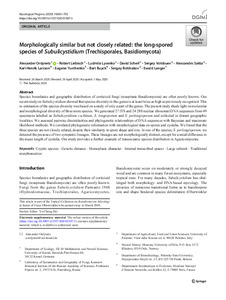Date
2020-06-06Author
Ordynets, AlexanderLiebisch, RobertLysenko, LudmilaScherf, DavidVolobuev, SergeySaitta, AlessandroLarsson, Karl-HenrikYurchenko, EugeneBuyck, BartBolshakov, SergeyLanger, EwaldMetadata
Show full item record
Aufsatz

Morphologically similar but not closely related: the long-sporedspecies of Subulicystidium (Trechisporales, Basidiomycota)
Abstract
Species boundaries and geographic distribution of corticioid fungi (resupinate Basidiomycota) are often poorly known. Ourrecent study onSubulicystidiumshowed that species diversity in this genus is at least twice as high as previously recognized. Thisre-estimation of the species diversity was based on a study of only a part of the genus. The present study sheds light on molecularand morphological diversity of three more species. We generated 27 ITS and 24 28S nuclear ribosomal DNA sequences from 49specimens labelled asSubulicystidium cochleum,S. longisporumandS. perlongisporumand collected in distant geographiclocalities. We assessed pairwise dissimilarities and phylogenetic relationships of DNA sequences with Bayesian and maximumlikelihood methods. We correlated phylogenetic information with morphological data on spores and cystidia. We found that thethree species are not closely related, despite their similarity in spore shape and size. In one of the species,S. perlongisporum,wedetected the presence of two sympatric lineages. These lineages are not morphologically distinct, except for a small difference inthe mean length of cystidia. Our study provides a further example of transoceanic species distribution in Agaricomycetes
Citation
In: Mycological Progress Volume 19 / Issue 7 (2020-06-06) , S. 691-703 ; EISSN 1861-8952Sponsorship
Gefördert im Rahmen des Projekts DEALCitation
@article{doi:10.17170/kobra-202006231366,
author={Ordynets, Alexander and Liebisch, Robert and Lysenko, Ludmila and Scherf, David and Volobuev, Sergey and Saitta, Alessandro and Larsson, Karl-Henrik and Yurchenko, Eugene and Buyck, Bart and Bolshakov, Sergey and Langer, Ewald},
title={Morphologically similar but not closely related: the long-sporedspecies of Subulicystidium (Trechisporales, Basidiomycota)},
journal={Mycological Progress},
year={2020}
}
0500 Oax
0501 Text $btxt$2rdacontent
0502 Computermedien $bc$2rdacarrier
1100 2020$n2020
1500 1/eng
2050 ##0##http://hdl.handle.net/123456789/11605
3000 Ordynets, Alexander
3010 Liebisch, Robert
3010 Lysenko, Ludmila
3010 Scherf, David
3010 Volobuev, Sergey
3010 Saitta, Alessandro
3010 Larsson, Karl-Henrik
3010 Yurchenko, Eugene
3010 Buyck, Bart
3010 Bolshakov, Sergey
3010 Langer, Ewald
4000 Morphologically similar but not closely related: the long-sporedspecies of Subulicystidium (Trechisporales, Basidiomycota) / Ordynets, Alexander
4030
4060 Online-Ressource
4085 ##0##=u http://nbn-resolving.de/http://hdl.handle.net/123456789/11605=x R
4204 \$dAufsatz
4170
5550 {{Genetik}}
5550 {{Mikrobiologie}}
5550 {{Mykologie}}
5550 {{Homoplasie}}
7136 ##0##http://hdl.handle.net/123456789/11605
<resource xsi:schemaLocation="http://datacite.org/schema/kernel-2.2 http://schema.datacite.org/meta/kernel-2.2/metadata.xsd"> 2020-06-23T12:19:50Z 2020-06-23T12:19:50Z 2020-06-06 doi:10.17170/kobra-202006231366 http://hdl.handle.net/123456789/11605 Gefördert im Rahmen des Projekts DEAL eng Namensnennung 4.0 International http://creativecommons.org/licenses/by/4.0/ Cryptic species Genetic distance Homoplasic character Internal transcribed spacer Large subunit Traditional morphometrics 570 580 Morphologically similar but not closely related: the long-sporedspecies of Subulicystidium (Trechisporales, Basidiomycota) Aufsatz Species boundaries and geographic distribution of corticioid fungi (resupinate Basidiomycota) are often poorly known. Ourrecent study onSubulicystidiumshowed that species diversity in this genus is at least twice as high as previously recognized. Thisre-estimation of the species diversity was based on a study of only a part of the genus. The present study sheds light on molecularand morphological diversity of three more species. We generated 27 ITS and 24 28S nuclear ribosomal DNA sequences from 49specimens labelled asSubulicystidium cochleum,S. longisporumandS. perlongisporumand collected in distant geographiclocalities. We assessed pairwise dissimilarities and phylogenetic relationships of DNA sequences with Bayesian and maximumlikelihood methods. We correlated phylogenetic information with morphological data on spores and cystidia. We found that thethree species are not closely related, despite their similarity in spore shape and size. In one of the species,S. perlongisporum,wedetected the presence of two sympatric lineages. These lineages are not morphologically distinct, except for a small difference inthe mean length of cystidia. Our study provides a further example of transoceanic species distribution in Agaricomycetes open access Ordynets, Alexander Liebisch, Robert Lysenko, Ludmila Scherf, David Volobuev, Sergey Saitta, Alessandro Larsson, Karl-Henrik Yurchenko, Eugene Buyck, Bart Bolshakov, Sergey Langer, Ewald doi:10.1007/s11557-020-01587-3 Genetik Mikrobiologie Mykologie Homoplasie publishedVersion EISSN 1861-8952 Issue 7 Mycological Progress 691-703 Volume 19 false </resource>
The following license files are associated with this item:


